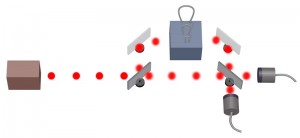First breakthrough in quantum cryptography in 30 years From ‘detecting’ to ‘preventing’ eavesdropping

Quantum cryptography exploits the properties of quantum mechanics to achieve highly secure communication without making any assumptions about the computational power and technology available to an eavesdropper. Conventional methods of quantum cryptography are all based on the uncertainty principle, which dictates that any eavesdropping attempt causes disturbance on the signal. Hence, through monitoring of the amount of noise in the communication channel, one is able to estimate the amount of the information leak.

© 2014 Toshihiko Sasaki.
Implementation of the proposed quantum cryptography scheme. The receiver superposes arbitrary pairs of optical pulses using a variable delay and measures them with photon detectors.
Professor Masato Koashi and Project Researcher Toshihiko Sasaki from the Photon Science Center in the University of Tokyo, in collaboration with Professor Yoshihisa Yamamoto from National Institute of Informatics, have proposed a method of quantum cryptography working on an entirely different principle. The researchers proved that using their method it is possible to achieve secure communication without monitoring the amount of noise in the communication channel. A basic implementation of this method can be created by a combination of a laser source and an interferometer, and there is no way for an eavesdropper to acquire information beyond a small fixed amount.
This discovery brings about a paradigm shift from ‘detecting eavesdropping’ to ‘preventing eavesdropping.’ In comparison to conventional methods of quantum cryptography, the new method is free from the cost of channel monitoring and it makes it possible to achieve secret communication even when a communication channel suffers from a large quantity of noise. This result has revealed what is essentially a new way of exploiting the properties of quantum mechanics that had gone unnoticed over quantum cryptography’s 30 years of history, and hence the concept is expected to have broad applications beyond cryptography.
Paper
Toshihiko Sasaki, Yoshihisa Yamamoto, Masato Koashi,
“Practical quantum key distribution protocol without monitoring signal disturbance”,
Nature Online Edition: 2014/5/22, doi: 10.1038/nature13303.
Article link (Publication, UTokyo Repository)
Links
Graduate School of Engineering
Photon Science Center, Graduate School of Engineering (Japanese)
Department of Applied Physics, Graduate School of Engineering
Koashi Laboratory, Photon Science Center, Graduate School of Engineering (Japanese)






